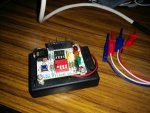The bear
Senior Member
Hi Everyone,
I would like to construct a timer that will ADD 2 mins. to a delay of say 30 mins. once every 24 hrs. So the next day the delay will= 32mins.
This is to control house lighting, comes on at dusk, goes off when the delay has timed out. The initial 30 mins delay would be for the longest day.
I would also require the timer to Subtract 2mins. each day, as the days get longer. The shortest day would require a delay of 6 hrs.
It will be controlled by a LDR, the plan is for the LDR to trigger the Picaxe to increment or decrement as required.
The hardware exists(CMOS), it has to be adjusted manually each week, as the days (Daylight) increases and decreases.
If successful it will replace the existing hardware.
Any pointers/ideas gratefully received.
Regards, Bear..
I would like to construct a timer that will ADD 2 mins. to a delay of say 30 mins. once every 24 hrs. So the next day the delay will= 32mins.
This is to control house lighting, comes on at dusk, goes off when the delay has timed out. The initial 30 mins delay would be for the longest day.
I would also require the timer to Subtract 2mins. each day, as the days get longer. The shortest day would require a delay of 6 hrs.
It will be controlled by a LDR, the plan is for the LDR to trigger the Picaxe to increment or decrement as required.
The hardware exists(CMOS), it has to be adjusted manually each week, as the days (Daylight) increases and decreases.
If successful it will replace the existing hardware.
Any pointers/ideas gratefully received.
Regards, Bear..


